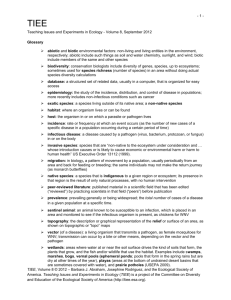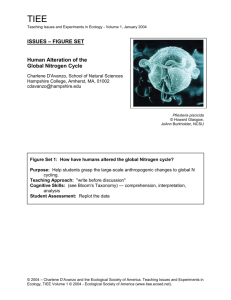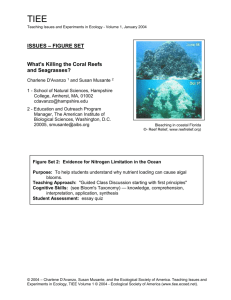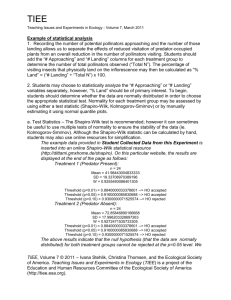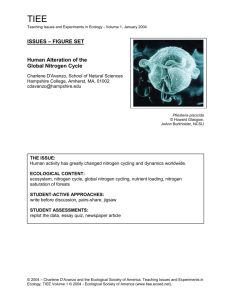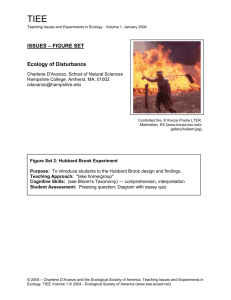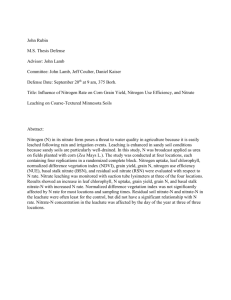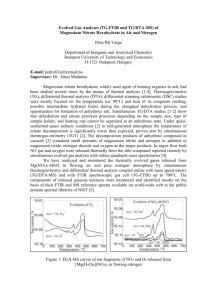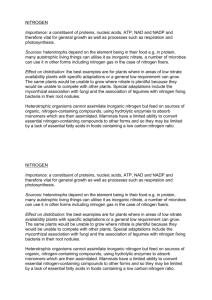nitrogen_fig3 - Ecological Society of America
advertisement
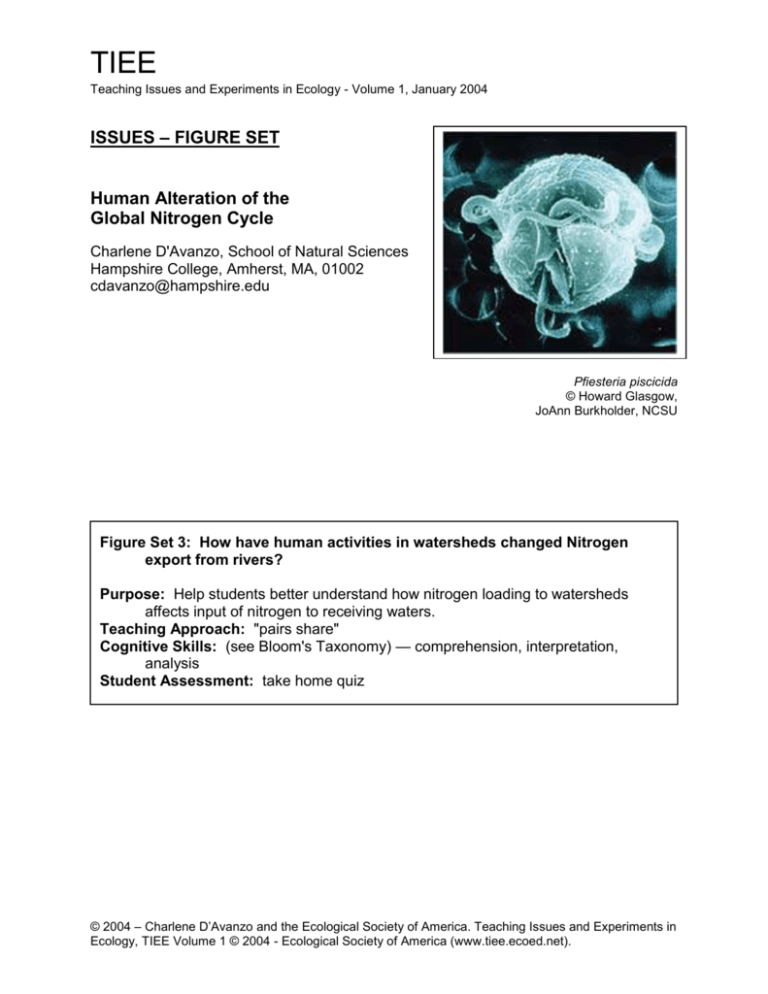
TIEE Teaching Issues and Experiments in Ecology - Volume 1, January 2004 ISSUES – FIGURE SET Human Alteration of the Global Nitrogen Cycle Charlene D'Avanzo, School of Natural Sciences Hampshire College, Amherst, MA, 01002 cdavanzo@hampshire.edu Pfiesteria piscicida © Howard Glasgow, JoAnn Burkholder, NCSU Figure Set 3: How have human activities in watersheds changed Nitrogen export from rivers? Purpose: Help students better understand how nitrogen loading to watersheds affects input of nitrogen to receiving waters. Teaching Approach: "pairs share" Cognitive Skills: (see Bloom's Taxonomy) — comprehension, interpretation, analysis Student Assessment: take home quiz © 2004 – Charlene D’Avanzo and the Ecological Society of America. Teaching Issues and Experiments in Ecology, TIEE Volume 1 © 2004 - Ecological Society of America (www.tiee.ecoed.net). page 2 Charlene D’Avanzo TIEE Volume 1, January 2004 BACKGROUND Over the last decade or so several synthetic studies have documented the very large effects of - fertilizer use in agriculture, other agricultural activities, and increased human population in coastal watersheds - on N concentrations in surface waters and estuaries. These include papers by Cole et al. (1993), Howarth et al. (1996), Jordan and Weller (1996), and Nixon (1995). Rivers receive mobile ions such as nitrate from the watersheds that they drain. Given factors such as increases in fertilizer use, nutrient inputs from sewage treatment plants, and N deposition as precipitation it is not surprising that nitrate concentrations have greatly increased worldwide. For instance, according to Vitousek et al. (1997) nitrate has more than doubled in the Mississippi since 1965 and concentrations of nitrate in majors rivers in the northeast has increased 3-10x since the early 1990's. Howarth et al. (1996) and Jordan and Weller (1996) correlate riverine nitrate discharge to population density both in the U.S. and worldwide. The positive relationship between total N flux as nitrate and human population density is to be expected given the mobility of nitrate. Still, the validity of the relationship for rivers over the globe is striking. Jordan and Weller (1996) show that total net anthropogenic input to watersheds is a much better predictor of U.S. nitrate discharge than any individual component. The r2 values they report are: net anthropogenic N input (0.76), agricultural biotic N fixation (0.62), atmospheric deposition (0.61), livestock waste (0.44), N fertilizer (0.36), human density (0.23), import of agricultural-product N (0.22), and percent cropland in watershed (0.08). Recent collaborative work of scientists worldwide has resulted in data such as Figure 3. In the Atlantic Ocean Basin total dissolved N into rivers is estimated to have increased by 2-20x since pre-industrial times (Vitousek et al. 1997b). The correlation between net anthropogenic inputs of N and total N fluxes for these data is quite high (r2 = 0.73; P=0.002; Howarth et al. 1996). For most of the regions around the North Atlantic fertilizers account for most anthropogenic inputs but atmospheric deposition of oxidized N is greatest for the northeast U.S. and Saint Lawrence River and Great Lakes Basin (Vitousek et al. 1997a). Several of the articles in Links (below) also discuss organic loss export from rivers plus large losses in watersheds as a result of denitrificiation. The Rabalais testimony shows effects of huge N loadings to the Gulf of Mexico (hypoxia, anoxia) from the Mississipi River. © 2004 – Charlene D’Avanzo and the Ecological Society of America. Teaching Issues and Experiments in Ecology, TIEE Volume 1 © 2004 - Ecological Society of America (www.tiee.ecoed.net). TIEE ISSUES FIGURE SET Human Alteration of the Nitrogen Cycle - Figure Set 3 page 3 Literature Cited Cole, J. J., B. L. Peierls, N. F. Caraco, and M. L. Pace. 1997. Nitrogen loading of rivers as a human-driven process. In M. J. McDonnell and S. T. A. Pickett, eds. Humans as components of ecosystems: the ecology of subtle human effects and populated areas. Springer-Verlag, N. Y. Howarth, R. W., G. Billen, D. Swaney, A. Townsend, N. Jaworski, K, Lajtha, A. Downing, R. Elmgreen, N. Caraco, T. Jordan, F. Berendse, J. Freney, V. Kudeyarov, P. Murdoch, and Z. Zhao-liang. 1996. Regional nitrogen budgets and riverine N & P fluxes for the drainages to the North Atlantic Ocean: Natural and human influences. Biogeochemistry 35: 181-226. Vitousek, P. M., J. D. Aber, R.W. Howarth, G. E. Likens, P. A. Matson, D. W. Schindler, W. H. Schlesinger, and D. G. Tilman, 1997a. Human alteration of the global nitrogen cycle: sources and consequences. Ecological Applications 7: 737-750. Vitousek, P. M., J. D. Aber, R.W. Howarth, G. E. Likens, P. A. Matson, D. W. Schindler, W. H. Schlesinger, and D. G. Tilman, 1997b Human alteration of the global nitrogen cycle: causes and consequences. Issues in Ecology 1: 1-15. Jordan, T. E., and D. E. Weller. 1996. Human contributions to terrestrial nitrogen flux. BioScience 46 655-664. Nixon, S. W. 1995. Coastal marine eutrophication: a definition, social causes, and future concerns. Ophelia 41: 199-219. Links www.esf.edu/for/boyer/vitae/boyer_etal_2002.pdf (PDF of Boyer et al. 2002. Anthropogenic nitrogen sources and relationships to riverine nitrogen export in the northeastern USA. Biogeochemistry 57/58:137-169) oaspub.epa.gov/eims/direntrpt.report?p_deid=7303&p_chk=4814 (EPA data on export from watersheds) www.bigelow.org/virtual/water_sub1.html (What's a watershed?; includes "Locate your watershed" link) www.nature.com/nature/journal/v415/n6870/fig_tab/415381a_F1.html (Nature figure - Forms of nitrogen storage in, or export from, two ecosystems in North and South America - shows large loss of N from denitrification in North America plus dissolved organic N loss in South America) biology.queensu.ca/~biol534/Howarth.pdf (RW Howarth. 1998. An assessment of human influences on fluxes of nitrogen from terrestrial landscapes to estuaries and continental shelves of the North Atlantic Ocean. Nutrient Cycling in Agroecosystems 52: 211-223; shows high correlation of export with human activities and that 80% is stored on the landscape or lost through denitrification) oceancommission.gov/meetings/mar7_8_02/rabalais_statement.pdf (Nancy Rabalis testimony about consequences of huge N loading from the Mississippi River to the coast) © 2004 – Charlene D’Avanzo and the Ecological Society of America. Teaching Issues and Experiments in Ecology, TIEE Volume 1 © 2004 - Ecological Society of America (www.tiee.ecoed.net). Charlene D’Avanzo page 4 TIEE Volume 1, January 2004 STUDENT INSTRUCTIONS In this "pairs-share" you first work on your Figure by yourself. Use the step onestep two approach you have practiced in class.* Then address the questions posed to you. After this you will pair up with a student who has focused on the other data set and the two of you will explain the figures/table to each other and also address the questions. Some Background Information and Questions Over the last decade or so scientists have tried to document the very large effects of human activities on N concentrations in surface waters and estuaries. (Human-caused effects are called "anthropogenic"). Increasing rates of "N loading" to rivers and to the coast has resulted in severe problems such as massive algal growth followed by oxygen depletion and accompanying "fish kills." (Why?) This phenomenon is eutrophication. The N increases are a result of synthetic fertilizer use in agriculture, other agricultural activities, sewage, and N in precipitation. Figure 3A Rivers receive mobile anions (negatively charged ions that easily leach out of soils) such as nitrate (NO3-) from the watersheds that they drain. Given factors such as increases in fertilizer use, nutrient inputs from sewage treatment plants, and N deposition as precipitation it is not surprising that nitrate concentrations in water bodies have greatly increased worldwide. According to Vitousek et al. (1997) nitrate concentration has more than doubled in the Mississippi River since 1965 and in majors rivers in the northeast they have increased 3-10x since the early 1990's. These are huge changes in a very short time! Figure 3A is an example of an ecosystem approach to the study of human alteration of global N cycling. Note the log-log scale and make sure you understand what log-log means. What is the question that the scientists who constructed this figure were asking? Questions What is meant by the term "export"? Where is the nitrate exported to? Why does nitrate export in rivers increase with increasing human population? What human activities result in increases in river nitrate concentrations? What are some effects of high nitrate concentration in water? © 2004 – Charlene D’Avanzo and the Ecological Society of America. Teaching Issues and Experiments in Ecology, TIEE Volume 1 © 2004 - Ecological Society of America (www.tiee.ecoed.net). TIEE ISSUES FIGURE SET Human Alteration of the Nitrogen Cycle - Figure Set 3 page 5 Figure 3B Recent collaborative work of scientists worldwide has resulted in data such as Figure 2B. In the Atlantic Ocean Basin total dissolved N into rivers is estimated to have increased by 2-20x since pre-industrial times (Vitousek et al. 1997b). For most of the regions around the North Atlantic fertilizers account for most anthropogenic inputs but atmospheric deposition of oxidized N (such as nitrous oxide) is greatest for the northeast U.S. and Saint Lawrence River and Great Lakes Basin (Vitousek et al. 1997a). Questions The data are labeled as flux (or input) per area? Per area of what? What does "flux" mean? What is total N (as opposed to nitrate for instance)? The data points are export of nitrate from watersheds to the North Atlantic Ocean. What is the watershed for the data point labeled NE U.S.? For the North Sea? How does the water actually enter the Atlantic Ocean - where does it come from and where would you go to see "it" enter? Synthesis of these data was an enormous undertaking for scientists from many nations. Why are these scientists so interested in the relationship between N flux and net anthropogenic input? Vitousek, P. M., J. D. Aber, R.W. Howarth, G. E. Likens, P. A. Matson, D. W. Schindler, W. H. Schlesinger, and D. G. Tilman, 1997a. Human alteration of the global nitrogen cycle: sources and consequences. Ecological Applications 7: 737-750. Vitousek, P. M., J. D. Aber, R.W. Howarth, G. E. Likens, P. A. Matson, D. W. Schindler, W. H. Schlesinger, and D. G. Tilman, 1997b Human alteration of the global nitrogen cycle: causes and consequences. Issues in Ecology 1: 1-15. * In step one you first figure out how the figure or table is set up (e.g. what the labels on the axes mean). You also need to have a pretty good idea of the experimental design - how the researchers set up their study - and the hypotheses the study address. In step two you can go on to interpreting the data. For both steps write down any questions you have. © 2004 – Charlene D’Avanzo and the Ecological Society of America. Teaching Issues and Experiments in Ecology, TIEE Volume 1 © 2004 - Ecological Society of America (www.tiee.ecoed.net). page 6 Charlene D’Avanzo TIEE Volume 1, January 2004 FIGURES Figure 3A. Export of nitrate from river systems worldwide as a function of human population in the watershed. From I. Valiela. Marine Ecological Processes, Second edition. 1995. Springer-Verlag, N.Y. and J. J. Cole, B. L. Peierls, N. F. Caraco, and M. L. Pace. 1997. Nitrogen loading of rivers as a human-driven process. In M. J. McDonnell and S. T. A. Pickett, eds. Humans as components of ecosystems: the ecology of subtle human effects and populated areas. SpringerVerlag, N.Y. © 2004 – Charlene D’Avanzo and the Ecological Society of America. Teaching Issues and Experiments in Ecology, TIEE Volume 1 © 2004 - Ecological Society of America (www.tiee.ecoed.net). TIEE ISSUES FIGURE SET Human Alteration of the Nitrogen Cycle - Figure Set 3 page 7 Figure 3B. Export of total N from watersheds surrounding the North Atlantic Ocean as a function of net human-caused inputs to their watersheds. Human related inputs are synthetic N fertilizer application, N fixation by leguminous crops, atmospheric inputs of N, and net imports of N in food and feedstock. From P. M. Vitousek, J. D. Aber, R. W. Howarth, G. E. Likens, P. A. Matson, D. W. Schindler, W. H. Schlesinger, and D. G. Tilman, 1997. Human alteration of the global nitrogen cycle: causes and consequences. Issues in Ecology 1: 1-15..and R. W. Howarth, G. Billen, D. Swaney, A. Townsend, N. Jaworski, K, Lajtha, A. Downing, R. Elmgreen, N. Caraco, T. Jordan, F. Berendse, J. Freney, V. Kudeyarov, P. Murdoch, and Z. Zhao-liang. 1996. Regional nitrogen budgets and riversine N & P fluxes for the drainages to the North Atlantic Ocean: Natural and human influences. Biogeochemistry 35: 181-226. © 2004 – Charlene D’Avanzo and the Ecological Society of America. Teaching Issues and Experiments in Ecology, TIEE Volume 1 © 2004 - Ecological Society of America (www.tiee.ecoed.net). page 8 Charlene D’Avanzo TIEE Volume 1, January 2004 FACULTY NOTES Pairs-share In this "pairs-share" one student is given Fig. 3 A and the other is given Fig. 3B. There are separate explanations of the figures for each one. Each student is also given a set of questions. They are instructed to examine their figure alone, try to answer the questions posed to them as best they can, and then pair up with someone who has the other figure. The students explain their respective figures and discuss their respective questions. The idea is that they will better understand export of N from rivers into oceans with both sets of figures. This "pairs-share" will take a fair amount of time. To save time, you can project the figures and lead a discussion using some of the questions below. Figures 3A and 3B These Figures synthesize large data sets from rivers around the world. In addition to helping students interpret the data, you should also encourage them to think about how the authors went about pulling together water chemistry data from rivers as different as the Mississippi, the Ganges, and the Amazon. Students are not used to thinking about data that a scientist collects, works up, and publishes. What are likely sources of the kind of data presented here? (E.g. departments of health and ministries of environment gray literature, EPA reports). What would be criteria for judgment of a valid data set to use in this synthesis? (E.g. samples collected throughout the year for at least several years, from different site, with good methodology). Figure 3A is a log-log plot. For some reason students become fearful at the mention of "log" and many believe that they cannot understand what a log is. Log 10 is not a difficult concept of course; one simple technique that has worked for me is to ask students to use a calculator (or spreadsheet) and go back and forth between the numbers 0.1, 1, 10, 100, and 1000 and their logs. They quickly see that logs are no mystery at all. In discussion ask students to describe how increased human density results in increased nitrate export in rivers. Get as much detail as they can provide and explain the biological or chemical mechanisms underlying their suggestions. For Figure 3A and 3B it will be necessary to give a brief explanation of the statistics of correlation and perhaps of P values. (Correlation measures the degree to which two variables vary together; students may confuse this with regression, which expresses one variable as a function of the other). Also be sure that they understand the term "inputs per area". © 2004 – Charlene D’Avanzo and the Ecological Society of America. Teaching Issues and Experiments in Ecology, TIEE Volume 1 © 2004 - Ecological Society of America (www.tiee.ecoed.net). TIEE ISSUES FIGURE SET Human Alteration of the Nitrogen Cycle - Figure Set 3 page 9 Discussion Questions (some repeated from student instructions) Figure 3A What is meant by the term "export"? Where is the nitrate exported to? Why are these scientists interested in the relationship between nitrate export and human density? Why is nitrate so important to look at in this way? Why does nitrate export in rivers increase with increasing human population? What human activities result in increases in river nitrate concentrations? What are some effects of high nitrate concentration in water? Why are the data plotted on log/log scales? Is this "cheating"? As much as 80% of the N estimated from human activities in North American watershed is not accounted for by export in rivers. Much is lost by denitrification in watersheds. What is dentirification and what types of habitats would you expect to have high rates of denitrification? Using this information, how might you decrease nitrogen loading rates into rivers? Figure 3B The data are labeled as flux (or input) per area? Per area of what? What does "flux" mean? What is total N (as opposed to nitrate for instance)? The data points are export of nitrate from watersheds to the North Atlantic Ocean. What is the watershed for the data point labeled NE U.S.? For the North Sea? How does the water actually enter the Atlantic Ocean - where does it come from and where would you go to see "it" enter? Synthesis of these data was an enormous undertaking for scientists from many nations. Why are these scientists so interested in the relationship between N flux and net anthropogenic input? Jordan, T. E., and D. E. Weller. 1996. Human contributions to terrestrial nitrogen flux. BioScience 46: 655-664. Student Assessment: Take home quiz. According to the paper by Jordan and Weller (1996) several anthropogenic environmental variables are correlated with average nitrate discharge to rivers. Here are their correlation coefficients for 8 variables: net anthropogenic nitrogen input (0.76), agricultural biotic nitrogen fixation (0.62), atmospheric deposition (0.61), livestock waste (0.44), N fertilizer (0.36), human density (0.23), import of agricultural-product N (0.22), and percent cropland in watershed (0.08). In a one page essay, explain each of these variables as N sources to rivers. In your essay, also explain the concept of correlation as it applies in this example. (note: a correlation coefficient value of 1 is the highest value possible). © 2004 – Charlene D’Avanzo and the Ecological Society of America. Teaching Issues and Experiments in Ecology, TIEE Volume 1 © 2004 - Ecological Society of America (www.tiee.ecoed.net). page 10 Charlene D’Avanzo TIEE Volume 1, January 2004 Evaluating an Issue: How do you know whether it is working? On-going (also called formative) evaluation of the approaches your are using is critical to the success of student-active teaching. Why try out new ideas if you don't know whether or not they are working? This is a brief overview of formative evaluation. For more information, go to the Formative Evaluation essay in the Teaching Section. Course Goals: Formative evaluation only works if you have clearly described your course goals because the purpose of the evaluation is to assess whether a particular technique is helping students reach these goals. For instance, most of us have "learn important ecological concepts and information" as a course goal. If I reviewed the nitrogen cycle in a class, for evaluation I might ask students to sketch out a nitrogen cycle for a particular habitat or system. Each student could work alone in class. Alternatively, I might ask students to work in groups of 3 and give each group a different situation (e.g. a pond receiving nitrate from septic systems, an organic agricultural field, an agricultural field receiving synthetic fertilizer). The students could draw their flows on a large sheet of paper (or an overhead transparency) and present this to the rest of the class. The Minute Paper: Minute papers are very useful evaluative tools. If done well they give you good feedback quickly. Minute papers are done at the end of a class. The students are asked to respond anonymously to a short question that you ask. They take a minute or so to write their response in a 3x5 card or a piece of paper. You collect these and learn from common themes. In the next class it is important that you refer to one or two of these points so that students recognize that their input matters to you. The UW - FLAG site (www.wcer.wisc.edu/nise/cl1/flag/) gives a good deal of information about using minute papers including their limitations, how to phrase your question, step-by-step instructions, modifications, and the theory and research behind their use. © 2004 – Charlene D’Avanzo and the Ecological Society of America. Teaching Issues and Experiments in Ecology, TIEE Volume 1 © 2004 - Ecological Society of America (www.tiee.ecoed.net).
